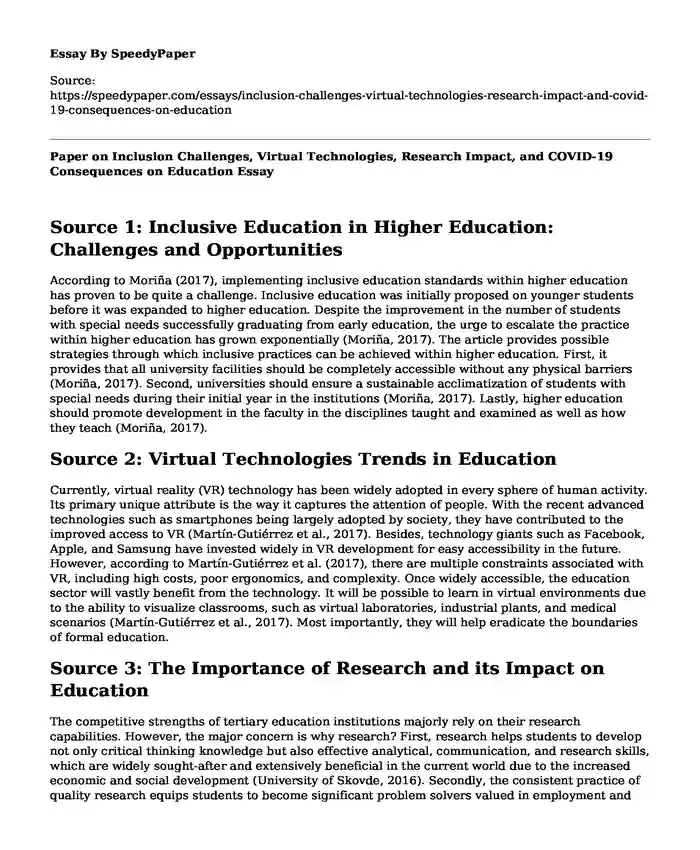
| Type of paper: | Essay |
| Categories: | High School Education Covid 19 |
| Pages: | 3 |
| Wordcount: | 707 words |
Source 1: Inclusive Education in Higher Education: Challenges and Opportunities
According to Moriña (2017), implementing inclusive education standards within higher education has proven to be quite a challenge. Inclusive education was initially proposed on younger students before it was expanded to higher education. Despite the improvement in the number of students with special needs successfully graduating from early education, the urge to escalate the practice within higher education has grown exponentially (Moriña, 2017). The article provides possible strategies through which inclusive practices can be achieved within higher education. First, it provides that all university facilities should be completely accessible without any physical barriers (Moriña, 2017). Second, universities should ensure a sustainable acclimatization of students with special needs during their initial year in the institutions (Moriña, 2017). Lastly, higher education should promote development in the faculty in the disciplines taught and examined as well as how they teach (Moriña, 2017).
Source 2: Virtual Technologies Trends in Education
Currently, virtual reality (VR) technology has been widely adopted in every sphere of human activity. Its primary unique attribute is the way it captures the attention of people. With the recent advanced technologies such as smartphones being largely adopted by society, they have contributed to the improved access to VR (Martín-Gutiérrez et al., 2017). Besides, technology giants such as Facebook, Apple, and Samsung have invested widely in VR development for easy accessibility in the future. However, according to Martín-Gutiérrez et al. (2017), there are multiple constraints associated with VR, including high costs, poor ergonomics, and complexity. Once widely accessible, the education sector will vastly benefit from the technology. It will be possible to learn in virtual environments due to the ability to visualize classrooms, such as virtual laboratories, industrial plants, and medical scenarios (Martín-Gutiérrez et al., 2017). Most importantly, they will help eradicate the boundaries of formal education.
Source 3: The Importance of Research and its Impact on Education
The competitive strengths of tertiary education institutions majorly rely on their research capabilities. However, the major concern is why research? First, research helps students to develop not only critical thinking knowledge but also effective analytical, communication, and research skills, which are widely sought-after and extensively beneficial in the current world due to the increased economic and social development (University of Skovde, 2016). Secondly, the consistent practice of quality research equips students to become significant problem solvers valued in employment and also can create more jobs in the world (University of Skovde, 2016). Lastly, research also enables students to get a better perspective of the world, solve mysteries, understand nature, and, most importantly, ensure a sustainable environment (University of Skovde, 2016).
Source 4: Impact of Covid-19 on Education
Since its emergence in early 2020, the Covid-19 global pandemic has significantly disrupted and stalled every aspect of human life (Feuer, 2020). In the mitigation process, strict and desperate measures have been explored to limit further adversities. Among the steps taken is the closure of schools where at the height of the pandemic, 192 countries have had schools shut down, and over 1.6 billion students worldwide left without physical learning (Feuer, 2020). Due to its effects on other vital sectors like the economy, not all students will be able to return to school. Educational services have also switched to virtual education services, which is not accessible to all. According to Feuer (2020), over 460 million students cannot access the internet, and more than 24 million students are expected to leave school. That not being enough; there is no possible reopening of schools at sight, hence the adversities of the pandemic on education sinking further.
References
Feuer, W. (2020, September 15). At least 24 million students could drop out of school due to the coronavirus pandemic, UN says. CNBC. https://www.cnbc.com/2020/09/15/at-least-24-million-students-could-drop-out-of-school-due-to-the-coronavirus-un-says.html
Martín-Gutiérrez, J., Mora, C. E., Añorbe-Díaz, B., & González-Marrero, A. (2017). Virtual technologies trends in education. EURASIA Journal of Mathematics, Science and Technology Education, 13(2), 469-486. https://doi.org/10.12973/eurasia.2017.00626a
Moriña, A. (2017). Inclusive education in higher education: challenges and opportunities. European Journal of Special Needs Education, 32(1), 3-17. https://doi.org/10.1080/08856257.2016.1254964
University of Skovde. (2016, December 8). The importance of research and its impact on education. https://www.studyinternational.com/news/the-importance-of-research-and-its-impact-on-education/
Cite this page
Paper on Inclusion Challenges, Virtual Technologies, Research Impact, and COVID-19 Consequences on Education. (2023, Dec 28). Retrieved from https://speedypaper.com/essays/inclusion-challenges-virtual-technologies-research-impact-and-covid-19-consequences-on-education
Request Removal
If you are the original author of this essay and no longer wish to have it published on the SpeedyPaper website, please click below to request its removal:
- Teen Pregnancy
- Free Essay Example: Learning Setting
- Essay Example on Alcohol Syndrome Disorder Speech Outline
- Benefits of a Diverse College Campus - Essay Sample
- The Healthcare - Free Paper Sample
- Navigating Adolescent Mental Health: Factors, Theories, and Interventions
- Free Paper Sample on Health Policy
Popular categories




